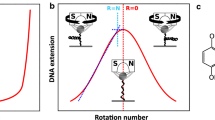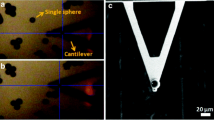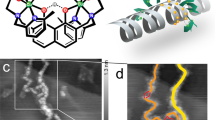Abstract
The advent of atomic force microscopy (AFM) provides a powerful tool for imaging individual DNA molecules. Chemotherapy drugs are often related to DNAs. Though many specific drug-DNA interactions have been observed by AFM, knowledge about the dynamic interactions between chemotherapy drugs and plasmid DNAs is still scarce. In this work, AFM was applied to investigate the nanoscale interactions between plasmid DNAs and two commercial chemotherapy drugs (methotrexate and cisplatin). Plasmid DNAs were immobilized on mica which was coated by silanes in advance. AFM imaging distinctly revealed the dynamic changes of single plasmid DNAs after the stimulation of methotrexate and cisplatin. Geometric features of plasmid DNAs were extracted from AFM images and the statistical results showed that the geometric features of plasmid DNAs changed significantly after the stimulation of drugs. This research provides a novel idea to study the actions of chemotherapy drugs against plasmid DNAs at the single-molecule level.
摘要
原子力显微镜(atomic forcemicroscopy, AFM)的出现为单根DNA分子形貌成像提供了新的技术手段. DNA是许多化疗药物的作用靶点. 尽管研究人员利用AFM对化疗药物与DNA之间的相互作用进行了大量研究, 但对于化疗药物与质粒DNA间动态相互作用过程的认知还很 缺乏. 本文利用AFM研究了纳米尺度下质粒DNA与两种商用化疗药物(甲氨蝶呤, 顺铂)之间的相互作用. 质粒DNA吸附在硅烷化的云母表 面. AFM成像结果清晰地揭示出化疗药物刺激下单根质粒DNA形貌的动态变化. 从AFM图像中提取出质粒DNA的几何特征, 统计结果表明 化疗药物刺激后质粒DNA的几何特征发生了显著变化. 本研究为单分子尺度下研究化疗药物与质粒DNA之间的相互作用提供了新的思路.
Similar content being viewed by others
References
Jemal A, Bray F, Center MM, et al. Global cancer statistics. CA Cancer J Clin, 2011, 61: 69–90
DeVita VT, Rosenberg SA. Two hundred years of cancer research. N Engl J Med, 2012, 366: 2207–2214
Nars MS, Kaneno R. Immunomodulatory effects of low dose chemotherapy and perspectives of its combination with immunotherapy. Int J Cancer, 2013, 132: 2471–2478
Nitiss JL. Targeting DN Atopoisomerase II in cancer chemotherapy. Nat Rev Cancer, 2009, 9: 338–350
Dupres V, Alsteens D, Andre G, et al. Fishing single molecules on live cells. Nano Today, 2009, 4: 262–268
Lyubchenko YL, Shlyakhtenko LS, Ando T. Imaging of nucleic acids with atomic force microscopy. Methods, 2011, 54: 274–283
Ido S, Kimiya H, Kobayashi K, et al. Immunoactive two-dimensional self-assembly of monoclonal antibodies in aqueous solution revealed by atomic forcemicroscopy. NatMater, 2014, 13: 264–270
Chiaruttini N, Redondo-Morata L, Colom A, et al. Relaxation of loaded ESCRT-III spiral springs drives membrane deformation. Cell, 2015, 163: 866–879
Alonso-Sarduy L, Longo G, Dietler G, et al. Time-lapse AFM imaging of DNA conformational changes induced by daunorubicin. Nano Lett, 2013, 13: 5679–5684
Krautbauer R, Clausen-Schaumann H, Gaub HE. Cisplatin changes the mechanics of single DNA molecules. Angew Chem Int Ed, 2000, 39: 3912–3915
Liu N, Bu T, Song Y, et al. The nature of the force-induced conformation transition of dsDNA studied by using singlemolecule force spectroscopy. Langmuir, 2010, 26: 9491–9496
Kodera N, Yamamoto D, Ishikawa R, et al. Video imaging of walkingmyosin V by high-speed atomic forcemicroscopy. Nature, 2010, 468: 72–76
Kalle W, Strappe P. Atomic force microscopy on chromosomes, chromatin and DNA: a review. Micron, 2012, 43: 1224–1231
Pyne A, Thompson R, Leung C, et al. Single-molecule reconstruction of oligonucleotide secondary structure by atomic force microscopy. Small, 2014, 10: 3257–3261
Li M, Liu L, Xi N, et al. Progress in measuring biophysical properties of membrane proteins with AFM single-molecule force spectroscopy. Chin Sci Bull, 2014, 59: 2717–2725
Li M, Xiao X, Liu L, et al. Rapid recognition and functional analysis of membrane proteins on human cancer cells using atomic force microscopy. J Immunological Methods, 2016, 436: 41–49
Wiggins PA, van der Heijden T, Moreno-Herrero F, et al. High flexibility of DNA on short length scales probed by atomic force microscopy. Nat Nanotech, 2006, 1: 137–141
Podesta A, Imperadori L, Colnaghi W, et al. Atomic force microscopy study of DNA deposited on poly l-ornithine-coatedmica. J Microsc, 2004, 215: 236–240
Hou XM, Zhang XH, Wei KJ, et al. Cisplatin induces loop structures and condensation of single DNA molecules. Nucleic Acids Res, 2009, 37: 1400–1410
Liu Z, Tan S, Zu Y, et al. The interactions of cisplatin and DNA studied by atomic force microscopy. Micron, 2010, 41: 833–839
Nuttall P, Lee K, Ciccarella P, et al. Single-molecule studies of unlabeled full-length p53 protein binding to DNA. J Phys Chem B, 2016, 120: 2106–2114
Cassina V, Manghi M, Salerno D, et al. Effects of cytosine methylation on DNA morphology: an atomic force microscopy study. BBA—Gen Subjects, 2016, 1860: 1–7
Cassina V, Seruggia D, Beretta GL, et al. Atomic force microscopy study of DNA conformation in the presence of drugs. Eur Biophys J, 2011, 40: 59–68
Cesconetto EC, Junior FSA, Crisafuli FAP, et al. DNA interaction with Actinomycin D: mechanical measurements reveal the details of the binding data. Phys Chem Chem Phys, 2013, 15: 11070–11077
Rafique B, Khalid AM, Akhtar K, et al. Interaction of anticancer drug methotrexate with DNA analyzed by electrochemical and spectroscopic methods. Biosens Bioelectron, 2013, 44: 21–26
Heng JB, Aksimentiev A, Ho C, et al. The electromechanics ofDNA in a synthetic nanopore. Biophys J, 2006, 90: 1098–1106
Liu Z, Li Z, Zhou H, et al. Imaging DNA molecules onmica surface by atomic force microscopy in air and in liquid. Microsc Res Tech, 2005, 66: 179–185
Sun L, Zhao D, Zhang Y, et al. DNA adsorption and desorption on mica surface studied by atomic forcemicroscopy. Appl Surface Sci, 2011, 257: 6560–6567
Miyagi A, Ando T, Lyubchenko YL. Dynamics of nucleosomes assessed with time-lapse high-speed atomic force microscopy. Biochemistry, 2011, 50: 7901–7908
Ficarra E, Masotti D, Macii E, et al. Automatic intrinsic DNA curvature computation from AFM images. IEEE Trans Biomed Eng, 2005, 52: 2074–2086
Thomson NH, Santos S, Mitchenall LA, et al. DNA G-segment bending is not the sole determinant of topology simplification by type II DNA topoisomerases. Sci Rep, 2014, 4: 6158
Jo K, Dhingra DM, Odijk T, et al. A single-molecule barcoding system using nanoslits for DNA analysis. Proc Natl Acad Sci USA, 2007, 104: 2673–2678
Brinkers S, Dietrich HRC, de Groote FH, et al. The persistence length of double stranded DNA determined using dark field tethered particle motion. J Chem Phys, 2009, 130: 215105–215105
Brunet A, Tardin C, Salomé L, et al. Dependence of DNA persistence length on ionic strength of solutions with monovalent and divalent salts: a joint theory–experiment study. Macromolecules, 2015, 48: 3641–3652
Geggier S, Kotlyar A, Vologodskii A. Temperature dependence of DNA persistence length. Nucleic Acids Res, 2011, 39: 1419–1426
Canetta E, Riches A, Borger E, et al. Discrimination of bladder cancer cells from normal urothelial cells with high specificity and sensitivity: combined application of atomic force microscopy and modulated Raman spectroscopy. Acta Biomater, 2014, 10: 2043–2055
Linko V, Ora A, Kostiainen MA. DNA nanostructures as smart drug-delivery vehicles and molecular devices. Trends Biotech, 2015, 33: 586–594
Wu N, Willner I. pH-stimulated reconfiguration and structural isomerization of origami dimer and trimer systems. Nano Lett, 2016, 16: 6650–6655
van Loenhout MTJ, de Grunt MV, Dekker C. Dynamics of DNA supercoils. Science, 2012, 338: 94–97
Oberstrass FC, Fernandes LE, Bryant Z. Torque measurements reveal sequence-specific cooperative transitions in supercoiled DNA. Proc Natl Acad Sci USA, 2012, 109: 6106–6111
Pontinha ADR, Jorge SMA, Chiorcea Paquim AM, et al. In situ evaluation of anticancer drug methotrexate–DNA interaction using a DNA-electrochemical biosensor and AFM characterization. Phys Chem Chem Phys, 2011, 13: 5227–5234
Dasari S, Bernard Tchounwou P. Cisplatin in cancer therapy: molecular mechanisms of action. Eur J Pharmacology, 2014, 740: 364–378
Li M, Liu LQ, Xi N, et al. Effects of temperature and cellular interactions on the mechanics and morphology of human cancer cells investigated by atomic force microscopy. Sci China Life Sci, 2015, 58: 889–901
Li M, Xiao X, Liu L, et al. Nanoscale quantifying the effects of targeted drug on chemotherapy in lymphoma treatment using atomic force microscopy. IEEE Trans Biomed Eng, 2016, 63: 2187–2199
Ando T, Uchihashi T, Scheuring S. Filming biomolecular processes by high-speed atomic force microscopy. Chem Rev, 2014, 114: 3120–3188
Acknowledgments
This work was supported by the National Natural Science Foundation of China (61503372, 61522312, 61327014 and 61433017), the Youth Innovation Promotion Association CAS, and the CAS FEA International Partnership Program for Creative Research Teams.
Author information
Authors and Affiliations
Corresponding authors
Additional information
Mi Li is currently an associate professor at the State Key Laboratory of Robotics, Shenyang Institute of Automation, Chinese Academy of Sciences, Shenyang, China. His research interests include AFM-based imaging and mechanical analysis of biological systems.
Lianqing Liu is currently a professor at the State Key Laboratory of Robotics, Shenyang Institute of Automation, Chinese Academy of Sciences, Shenyang, China. His research interests include micro/nano system, nanodevice fabrication, nanobiotechnology and biosensors.
Ning Xi is currently a John D. Ryder Professor of Electrical and Computer Engineering at Michigan State University, East Lansing and a professor of Shenyang Institute of Automation, Chinese Academy of Sciences, Shenyang, China. His research interests include robotics, manufacturing automation, nanosensors, micro/nanomanufacturing, and intelligent control and systems.
Rights and permissions
About this article
Cite this article
Li, M., Liu, L., Xiao, X. et al. The dynamic interactions between chemotherapy drugs and plasmid DNA investigated by atomic force microscopy. Sci. China Mater. 60, 269–278 (2017). https://doi.org/10.1007/s40843-016-5152-2
Received:
Accepted:
Published:
Issue Date:
DOI: https://doi.org/10.1007/s40843-016-5152-2




